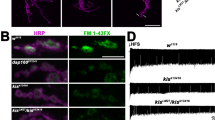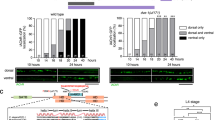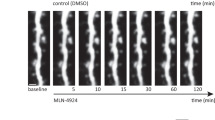Abstract
The covalent attachment of ubiquitin to cellular proteins is a powerful mechanism for controlling protein activity and localization1. Ubiquitination is a reversible modification promoted by ubiquitin ligases and antagonized by deubiquitinating proteases2. Ubiquitin-dependent mechanisms regulate many important processes including cell-cycle progression, apoptosis and transcriptional regulation3. Here we show that ubiquitin-dependent mechanisms regulate synaptic development at the Drosophila neuromuscular junction (NMJ). Neuronal overexpression of the deubiquitinating protease fat facets4 leads to a profound disruption of synaptic growth control; there is a large increase in the number of synaptic boutons, an elaboration of the synaptic branching pattern, and a disruption of synaptic function. Antagonizing the ubiquitination pathway in neurons by expression of the yeast deubiquitinating protease UBP2 (ref. 5) also produces synaptic overgrowth and dysfunction. Genetic interactions between fat facets and highwire6, a negative regulator of synaptic growth that has structural homology to a family of ubiquitin ligases, suggest that synaptic development may be controlled by the balance between positive and negative regulators of ubiquitination.
This is a preview of subscription content, access via your institution
Access options
Subscribe to this journal
Receive 51 print issues and online access
$199.00 per year
only $3.90 per issue
Buy this article
- Purchase on Springer Link
- Instant access to full article PDF
Prices may be subject to local taxes which are calculated during checkout




Similar content being viewed by others
References
Hochstrasser, M. Ubiquitin-dependent protein degradation. Annu. Rev. Genet. 30, 405–439 (1996).
Wilkinson, K. D. Regulation of ubiquitin-dependent processes by deubiquitinating enzymes. FASEB J. 11, 1245–1256 (1997).
Hershko, A. & Ciechanover, A. The ubiquitin system. Annu. Rev. Biochem. 67, 425–479 (1998).
Huang, Y., Baker, R. T. & Fischer-Vize, J. A. Control of cell fate by a deubiquitinating enzyme encoded by the fat facets gene. Science 270, 1828–1831 (1995).
Baker, R. T., Tobias, J. W. & Varshavsky, A. Ubiquitin-specific proteases of Saccharomyces cerevisiae. Cloning of UBP2 and UBP3, and functional analysis of the UBP gene family. J. Biol. Chem. 267, 23364–23375 (1992).
Wan, H. I. et al. Highwire regulates synaptic growth in Drosophila. Neuron 26, 313–329 (2000).
Rorth, P. et al. Systematic gain-of-function genetics in Drosophila. Development 125, 1049–1057 (1998).
DiAntonio, A. & Schwarz, T. L. The effect on synaptic physiology of synaptotagmin mutants in Drosophila. Neuron 12, 909–920 (1994).
Wu, Z., Li, Q., Fortini, M. E. & Fischer, J. A. Genetic analysis of the role of the Drosophila fat facets gene in the ubiquitin pathway. Dev. Genet. 25, 312–320 (1999).
Joazeiro, C. A. & Weissman, A. M. RING finger proteins: mediators of ubiquitin ligase activity. Cell 102, 549–552 (2000).
Fischer-Vize, J. A., Rubin, G. M. & Lehmann, R. The fat facets gene is required for Drosophila eye and embryo development. Development 116, 985–1000 (1992).
Chen, X. & Fischer, J. A. In vivo structure/function analysis of the Drosophila fat facets deubiquitinating enzyme gene. Genetics 156, 1829–1836 (2000).
Petersen, S. A., Fetter, R. D., Noordermeer, J. N., Goodman, C. S. & DiAntonio, A. Genetic analysis of glutamate receptors in Drosophila reveals a retrograde signal regulating presynaptic transmitter release. Neuron 19, 1237–1248 (1997).
DiAntonio, A., Petersen, S. P., Heckmann, M. & Goodman, C. S. Glutamate receptor expression regulates quantal size and quantal content at the Drosophila neuromuscular junction. J. Neurosci. 19, 3023–3032 (1999).
Serdaroglu, P., Askanas, V. & Engel, W. K. Immunocytochemical localization of ubiquitin at human neuromuscular junctions. Neuropathol. Appl. Neurobiol. 18, 232–236 (1992).
Chapman, A. P., Smith, S. J., Rider, C. C. & Beesley, P. W. Multiple ubiquitin conjugates are present in rat brain synaptic membranes and postsynaptic densities. Neurosci. Lett. 168, 238–242 (1994).
Hegde, A. N. et al. Ubiquitin C-terminal hydrolase is an immediate-early gene essential for long-term facilitation in Aplysia. Cell 89, 115–126 (1997).
Jiang, Y. H. et al. Mutation of the Angelman ubiquitin ligase in mice causes increased cytoplasmic p53 and deficits of contextual learning and long-term potentiation. Neuron 21, 799–811 (1998).
Yao, K. M. & White, K. Neural specificity of elav expression: defining a Drosophila promoter for directing expression to the nervous system. J. Neurochem. 63, 41–51 (1994).
Brand, A. H. & Perrimon, N. Targeted gene expression as a means of altering cell fates and generating dominant phenotypes. Development 118, 401–415 (1993).
Schuster, C. M., Davis, G. W., Fetter, R. D. & Goodman, C. S. Genetic dissection of structural and functional components of synaptic plasticity. I. Fasciclin II controls synaptic stabilization and growth. Neuron 17, 641–654 (1996).
Stewart, B. A., Atwood, H. L., Renger, J. J., Wang, J. & Wu, C. F. Improved stability of Drosophila larval neuromuscular preparations in haemolymph-like physiological solutions. J. Comp. Physiol. A 175, 179–191 (1994).
Zito, K., Parnas, D., Fetter, R. D., Isacoff, E. Y. & Goodman, C. S. Watching a synapse grow: noninvasive confocal imaging of synaptic growth in Drosophila. Neuron 22, 719–729 (1999).
Acknowledgements
We would like to thank J. Fischer and K. Zinn for their gifts of reagents. This work was supported by the NIH and HHMI (C.S.G.), NSERC Canada (A.P.H.), and the Burroughs-Wellcome Career Award, HHMI, and Whitehall Foundation (A.D.).
Author information
Authors and Affiliations
Corresponding author
Rights and permissions
About this article
Cite this article
DiAntonio, A., Haghighi, A., Portman, S. et al. Ubiquitination-dependent mechanisms regulate synaptic growth and function. Nature 412, 449–452 (2001). https://doi.org/10.1038/35086595
Received:
Accepted:
Issue Date:
DOI: https://doi.org/10.1038/35086595
This article is cited by
-
Proteomic mapping of Drosophila transgenic elav.L-GAL4/+ brain as a tool to illuminate neuropathology mechanisms
Scientific Reports (2020)
-
Distinct homeostatic modulations stabilize reduced postsynaptic receptivity in response to presynaptic DLK signaling
Nature Communications (2018)
-
Molecular guidance cues in the development of visual pathway
Protein & Cell (2018)
-
Posttranslational Modifications Regulate the Postsynaptic Localization of PSD-95
Molecular Neurobiology (2017)
-
The PHR proteins: intracellular signaling hubs in neuronal development and axon degeneration
Neural Development (2016)
Comments
By submitting a comment you agree to abide by our Terms and Community Guidelines. If you find something abusive or that does not comply with our terms or guidelines please flag it as inappropriate.



